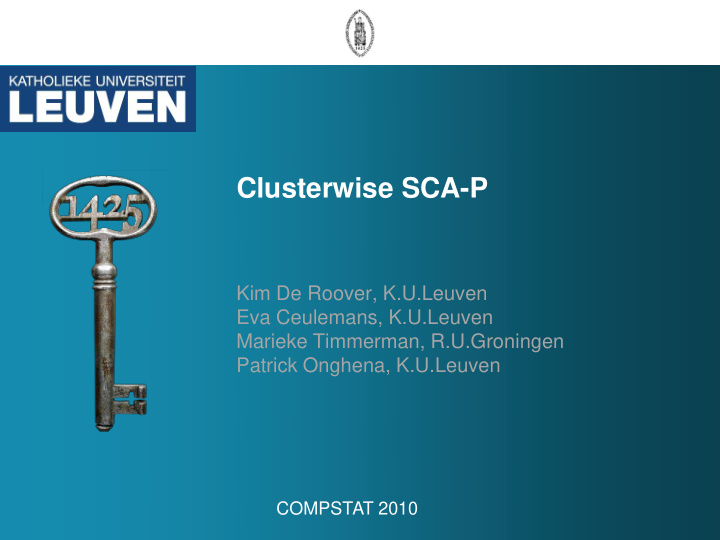



Clusterwise SCA-P Kim De Roover, K.U.Leuven Eva Ceulemans, K.U.Leuven Marieke Timmerman, R.U.Groningen Patrick Onghena, K.U.Leuven COMPSTAT 2010
Introduction • data from different subjects with multiple measurements of a number of variables differences and similarities between subjects in underlying structure of the data?
Illustrative application Data (Vansteelandt et al., 2006): • 10 subjects with eating disorder (anorexia and bulimia nervosa) • 22 variables measuring: drive for thinness, positive and negative emotional states, urge to be physically active, physical activity • 9 random measurement moments per day, during a week Research questions: (1) underlying structure of the variables? (2) interindividual differences in underlying structure?
Clusterwise SCA: Idea • general idea: - partition subjects into clusters - perform separate SCA per cluster
Clusterwise SCA: Model K k k p X FB ' E FB ' E i ik i i i i k i k 1
Clusterwise SCA-P: Model K k k X p FB ' E FB ' E i ik i i i i k i k 1 • for now, number of components per cluster equal for all clusters • more general than Clusterwise SCA-ECP (De Roover et al., 2010): – variances of components and correlations between components are allowed to vary between subjects within a cluster insight in differences between subjects in (co)variation of the components
Illustrative application Preprocessing of eating disorder data: • centre per subject differences in mean scores between subjects removed • standardize over the 10 subjects (instead of per subject) differences in variability of the scores retained
Illustrative application: Loadings rotation criterion: HKIC (Harris & Kaiser, Cluster 1 Cluster 2 1964) (5 subjects) (5 subjects) PA/NA (urge) ph. PA/NA PA & ph.act. act. & DFT positive and pleased .19 .80 .42 .47 negative affect happy .20 .80 .32 .62 (PA/NA) appreciated .14 .61 -.12 .76 love .23 .56 .01 .69 sad -.17 -.79 -.77 .08 angry -.01 -.79 -.60 .13 lonely -.01 -.71 -.62 -.02 ashamed .05 -.68 -.21 .08 anxious .03 -.75 -.41 .03 tense .10 -.68 -.49 -.24 guilty .05 -.81 -.44 .00 irritated .07 -.58 -.55 -.07 urge to be want to move .89 -.08 .30 -.23 physically active want to sport .94 -.13 .11 -.21 (urge ph. act.) want to be active .92 -.07 .28 -.27 physical activity am active .87 .20 -.10 .55 (ph. act.) am moving .87 .23 -.12 .59 am sporting .88 .29 .00 .19 drive for want to burn calories .89 -.16 .10 -.13 thinness (DFT) want to loose weight .32 -.48 .02 -.43 feel fat .33 -.66 -.02 -.13 feel ugly .55 -.60 -.02 -.20
Illustrative application: Validation of clustering significant difference between clusters in mean EDI (p = .04) 120 Eating Disorder Inventory 100 80 60 40 20 0 1 2 Cluster
Illustrative application: Variances/correlations per cluster variances variances subject PA/NA (urge) ph. act. & DFT correlations cluster 1 1 .91 .82 .17 2 1.01 .71 -.28 3 .89 1.31 -.18 4 1.20 1.11 -.05 10 1.03 .81 .05 overall correlation cluster 1 -.05 variances variances subject PA/NA PA & physical activity correlations cluster 2 5 1.45 .51 -.52 6 1.31 1.56 .45 7 .36 .46 .49 8 1.34 1.08 .45 9 .66 1.59 .12 overall correlation cluster 2 .21
Illustrative application: Variances/correlations per cluster .39 correlation -.11 correlation .99 correlation with EDI with EDI with EDI variances variances subject PA/NA (urge) ph. act. & DFT correlations cluster 1 1 .91 .82 .17 2 1.01 .71 -.28 3 .89 1.31 -.18 4 1.20 1.11 -.05 10 1.03 .81 .05 overall correlation cluster 1 -.05 variances variances subject PA/NA PA & physical activity correlations cluster 2 5 1.45 .51 -.52 6 1.31 1.56 .45 7 .36 .46 .49 8 1.34 1.08 .45 9 .66 1.59 .12 overall correlation cluster 2 .21 .21 correlation .89 correlation -.60 correlation with EDI with EDI with EDI
Discussion Clusterwise SCA-P: • captures structural differences and similarities in a parsimonious manner • makes it possible to examine differences in component variances and correlations between the subjects within a cluster • is applicable to all kinds of multivariate nested data, e.g., subjects nested within groups • number of components will be allowed to vary over clusters in the future
Recommend
More recommend